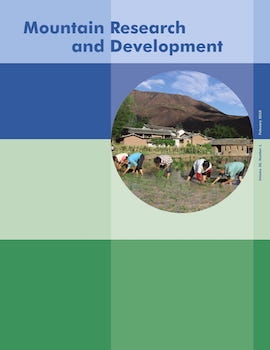Climate Change Impacts on High-Altitude Ecosystems by Münir Öztürk, Khalid Rehman Hakeem, I. Faridah-Hanum, and Recep Efe. Cham, Switzerland: Springer International Publishing, 2015. xvii + 696 pp. US$ 239.00. ISBN 978-3-319-12858-0.
Ecosystems at high elevations occur in mountain systems and plateaus across all of Earth’s major biomes and climate zones. While all are determined by low-temperature conditions, similarly cold environments and habitats may actually be located at different altitudes, depending on their orographic location, latitude, and longitude, and they may differ in terms of precipitation patterns and biological diversity. In tropical biomes, upper tree lines can reach above 4000 m and vascular plant species above 5000 m, with extreme outposts above 6000 m in the Himalaya; at the margins of the Arctic, the elevation limits of tree growth gradually drop to sea level. Given their worldwide distribution, high-mountain ecosystems and the composition of their biodiversity are considered to be sensitive indicators of the ecological consequences of global climate change—especially in regions where direct human impacts from traditional or modern land use practices are low. But global change impacts arising from land abandonment, land use intensification, and changes in anthropogenic atmospheric deposition are also subjects of concern when it comes to ecosystem persistence or degradation, and they can interfere with impacts arising from climate change.
This book describes the natural and anthropogenic vegetation and major ecosystem components at different elevations in several large mountain systems. It attempts to provide comprehensive insights into a range of interacting effects of climate and global change processes at high altitudes and their implications for ecosystem health and human well-being, as well as the provision of ecosystem services for food and medicine. The 28 chapters, however, are rather unbalanced both in their geographical focus and in the ecosystem features, anthropogenic influences, or socioeconomic interactions they consider. Eighteen chapters focus on regions located from Asia Minor eastwards to the central Himalaya and northeastwards to the western Altai, with particular emphasis on the mountains of Turkey and Pakistan, and less on the Caucasus, Middle to Central Asia (Tien Shan, Pamirs), and the Nepal Himalaya. Many of these chapters provide long descriptions of regional mountain landscapes and their vertical vegetation zonation, with examples of occurring species. Most include surrounding low-elevation areas as much as upland environments; and high-altitude ecosystems and their characteristics in the context of climate change repeatedly shift out of focus. Thus, the aims and research questions of the contributions often remain diffuse. In addition, repetition within or among chapters—for example, among 3 strongly overlapping chapters about a single mountain massif in westernmost Turkey—makes the book rather bulky to read. Some chapters, however, are well targeted and provide a wealth of valuable facts. Examples include the chapters on the Taurus Mountains in southern Turkey and the little-explored Pamir Mountains of Tajikistan.
All other chapters address particular components of mountain landscapes and ecosystems. The Americas are represented with 3 rather different contributions: One focuses on soil carbon reservoirs in the Andes; another, interesting, one investigates the origin and phylogeny of the legume genus Lupinus, with special reference to its elevational distribution in Mexico; and one examines interdependencies between anthropogenic impacts on nature and their impacts on human communities in California’s San Bernardino Mountains. The 2 chapters on mountains of the Balkan Peninsula describe the vegetation and flora in Macedonia, with some projections under climate change scenarios, and the development of mountain tourism in Bulgaria. In the latter chapter, references to climate change implications and to ecosystems are largely lacking. The 2 articles on southern and central Siberia both deal mainly with primary production in forest ecosystems. The chapters on Malaysia and Indonesia discuss low- to mid-elevation forests in the humid-tropical life zone. A global study of wetland habitats and bird diversity only marginally reflects the characteristics of high-altitude wetlands.
The chapters of the book are neither thematically nor geographically grouped, and readers may have difficulties orienting themselves and finding a common thread. The confusion is heightened by the fact that there is no introductory chapter (apart from a brief preface) and no overall summary or conclusion. The apparent lack of a thorough review process has led to a number of errors in regional species numbers, species names, and definitions of plant growth forms including suitable examples. Existing literature is often discussed only very briefly, with citations underreported. Many figures do little to help explain the context; labels and legends in the diagrams are often insufficient or missing, or hardly readable due to the small font size.
Beside a number of shortcomings, however, the publication holds some important messages. First, it displays the regionally very different levels of knowledge on, and exploration of, high-elevation ecosystems and their biotic components, especially among the mountain systems ranging from the Himalayas to Middle Asia and Asia Minor. Regional species inventories and vegetation descriptions are available, albeit at varied accuracy and spatial resolution, and some regional case studies on interactions with human land use practices merit particular consideration. Second, in most of the described mountain regions, there are few data series from permanent plot surveys suitable for the long-term observation of changing species compositions. Hence the book demonstrates the urgent need to set baselines for long-term research and monitoring, which in turn are indispensable for tracing unfavorable ecosystem alterations resulting from climate and global change. Thanks to the efforts of the editors and authors, this book makes gaps, needs, and demands in ecological high-mountain research more apparent. Future research should involve both disciplinary long-term approaches and interdisciplinary efforts considering the influence of human land use and the needs of local communities who depend on mountain ecosystems and the services they provide.





